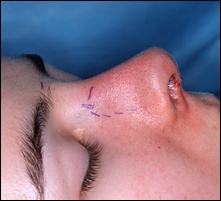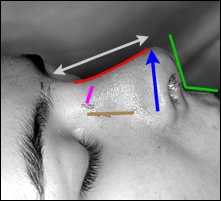 In this chapter we
discuss the nasal dressing. The operation is now over. This patient shows some of
the features I like to see at the end of a rhinoplasty. Her profile line
is ever so slightly concave, without looking scooped-out (red line).
The tip of her nose is strong, and it projects out a little bit beyond the line
of the dorsum (blue arrow). The nose is adequately short (length of the
arrowed white line), with an angle
between the upper lip and the bottom of the nose that is greater than a
90-degree right angle (green lines).
In this chapter we
discuss the nasal dressing. The operation is now over. This patient shows some of
the features I like to see at the end of a rhinoplasty. Her profile line
is ever so slightly concave, without looking scooped-out (red line).
The tip of her nose is strong, and it projects out a little bit beyond the line
of the dorsum (blue arrow). The nose is adequately short (length of the
arrowed white line), with an angle
between the upper lip and the bottom of the nose that is greater than a
90-degree right angle (green lines).
The purple lines on
the side of her nose in the color photograph are markings that I drew to help me design her
osteotomies, to narrow her nasal bones. Looking at the diagram above
right, the medial osteotomy was placed along the purple line and the lateral osteotomy
was made along the brown line.
Note that you can
see the shape of the final nose on the operating table if only a small amount of
swelling has developed by the end of the operation. Swelling
can obscure the surgeon's perception of the nose's shape and what needs to be
done during surgery. That's another factor that makes this operation
difficult to learn and difficult to perform. There are many tricks that a
savvy surgeon can use during surgery to help minimize intraoperative swelling.
|














